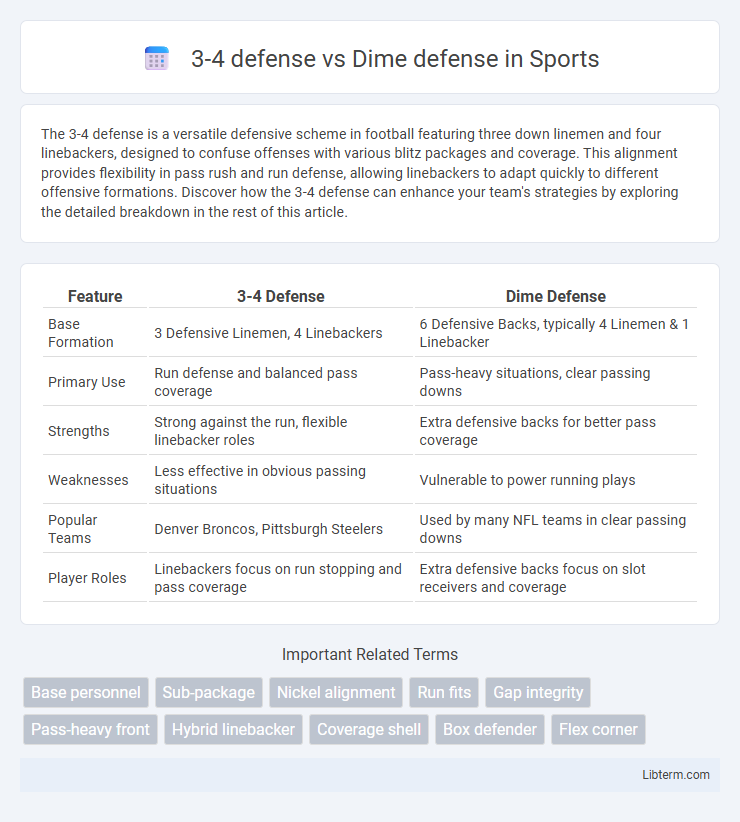The 3-4 defense is a versatile defensive scheme in football featuring three down linemen and four linebackers, designed to confuse offenses with various blitz packages and coverage. This alignment provides flexibility in pass rush and run defense, allowing linebackers to adapt quickly to different offensive formations. Discover how the 3-4 defense can enhance your team's strategies by exploring the detailed breakdown in the rest of this article.
Table of Comparison
| Feature | 3-4 Defense | Dime Defense |
|---|---|---|
| Base Formation | 3 Defensive Linemen, 4 Linebackers | 6 Defensive Backs, typically 4 Linemen & 1 Linebacker |
| Primary Use | Run defense and balanced pass coverage | Pass-heavy situations, clear passing downs |
| Strengths | Strong against the run, flexible linebacker roles | Extra defensive backs for better pass coverage |
| Weaknesses | Less effective in obvious passing situations | Vulnerable to power running plays |
| Popular Teams | Denver Broncos, Pittsburgh Steelers | Used by many NFL teams in clear passing downs |
| Player Roles | Linebackers focus on run stopping and pass coverage | Extra defensive backs focus on slot receivers and coverage |
Understanding the Basics: 3-4 Defense vs Dime Defense
The 3-4 defense employs three defensive linemen and four linebackers to provide a balanced mix of run-stopping and pass coverage, often confusing offenses with versatile linebacker blitzes. The Dime defense replaces linebackers with six defensive backs, optimizing for pass defense in obvious passing situations by enhancing coverage against multiple wide receivers. Understanding these formations helps teams adjust to offensive schemes, with the 3-4 focusing on flexibility and the Dime emphasizing perimeter defense and speed.
Core Formations: Structure of the 3-4 Defense
The 3-4 defense features three down linemen and four linebackers, designed to control the line of scrimmage and provide versatile pass coverage. Core formations include a nose tackle positioned over the center, two defensive ends responsible for controlling gaps, and outside linebackers who serve as primary pass rushers or coverage defenders. This structure contrasts with the dime defense, which employs six defensive backs to enhance pass defense, sacrificing some run-stopping power inherent to the 3-4's linebacker-heavy alignment.
Breaking Down the Dime Defense Alignment
The Dime defense employs six defensive backs, enhancing pass coverage against multiple wide receiver sets by replacing linebackers with defensive backs to increase speed and agility. Its alignment features four defensive linemen, one linebacker, and six defensive backs positioned to cover short and intermediate routes while supporting run defense, effectively disrupting quick passes and screens. This formation balances coverage versatility and pass rush potency, making it optimal against spread offenses frequently seen in modern football.
Personnel Packages: Who’s on the Field?
3-4 defense typically deploys three defensive linemen and four linebackers, focusing on versatile athletes capable of both run-stopping and pass coverage. Dime defense incorporates six defensive backs to enhance pass coverage against multiple wide receiver sets, often reducing linemen or linebackers. Personnel packages in 3-4 emphasize size and strength upfront, while Dime prioritizes speed and coverage skills in the secondary to defend against spread offenses.
Situational Usage: When to Deploy 3-4 or Dime
The 3-4 defense excels in situations requiring versatile linebacker play and effective run stopping, often deployed against teams favoring power running and balanced offenses. Dime defenses, featuring six defensive backs, are optimal in obvious passing situations, such as third-and-long, to enhance pass coverage and limit receiver options. Choosing between 3-4 and Dime depends on down, distance, and offensive personnel, balancing run defense strength with pass defense agility.
Strengths and Weaknesses: 3-4 Defense Analysis
The 3-4 defense excels in versatility by deploying three defensive linemen and four linebackers, enhancing pass coverage and run defense flexibility against diverse offensive formations. Its strength lies in disguising blitzes and improving linebacker agility, but it can be vulnerable against strong offensive lines due to fewer down linemen for gap control. Compared to the Dime defense, which prioritizes pass defense with six defensive backs, the 3-4 defense balances run stopping and pass rush, while the Dime sacrifices run defense strength for superior pass coverage in obvious passing situations.
Advantages and Vulnerabilities of the Dime Defense
Dime defense employs six defensive backs, enhancing pass coverage and effectively countering three or more wide receiver sets, which is advantageous against pass-heavy offenses. Its increased speed and agility improve defense against short and intermediate routes but create vulnerabilities in run defense due to fewer linebackers and linemen. The reduced front line personnel can be exploited by power-running teams, making the Dime defense less effective against strong ground attacks.
Stopping the Run: 3-4 vs Dime Effectiveness
The 3-4 defense excels against the run by deploying four linebackers who can fill gaps and engage blockers effectively, creating strong front-seven run defense. In contrast, the Dime defense, primarily designed for pass coverage with six defensive backs, often sacrifices run-stopping ability due to fewer linebackers and linemen present at the line of scrimmage. Consequently, the 3-4 defense generally demonstrates greater effectiveness in stopping the run compared to the Dime package, which prioritizes pass defense over run containment.
Pass Coverage Strategies: Comparing 3-4 and Dime
The 3-4 defense employs three defensive linemen and four linebackers, allowing for versatile pass coverage through zone and man-to-man schemes focused on both intermediate and short routes. The Dime defense uses six defensive backs to bolster pass defense against multiple wide receivers, emphasizing tight coverage on deep routes and quick reaction to passing plays. While the 3-4 provides balanced coverage with flexibility in blitzes, the Dime prioritizes coverage density, especially against spread offenses deploying high-volume passing attacks.
Choosing the Right Defense: Tactical Decision-Making
Choosing between a 3-4 defense and a dime defense hinges on offensive formations and strategic priorities. The 3-4 defense, featuring three defensive linemen and four linebackers, excels in versatility and run-stopping capabilities, making it effective against balanced offensive attacks. In contrast, the dime defense employs six defensive backs to counter multiple receiver sets, emphasizing pass coverage and speed to disrupt aerial threats.
3-4 defense Infographic

 libterm.com
libterm.com